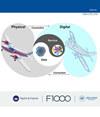数字孪生中的数据驱动建模用于电力系统异常检测
引用次数: 0
摘要
背景:电力系统异常检测对于实现系统态势感知和早期发现系统运行风险具有重要意义。鉴于系统运行工况复杂,机构中存在大量不透明环节,基于物理机构建模的异常检测方法在建模过程中由于假设、简化、转移等原因容易产生系统误差。本文主要介绍基于数字孪生的数据驱动电力系统异常检测方法,以弥补物理方法在动态建模中的局限性。方法:首先,基于数字孪生的概念,构建了用于电力系统实时分析的数字孪生框架。然后,本文对所设计框架的核心,即数字孪生建模进行了研究。考虑到电力系统运行状况的复杂性,本文优先采用数据驱动建模,并构建了基于随机矩阵和自由概率论的系统运行状况异常检测模型。结果:通过蒙特卡洛实验生成的不同时空结构的仿真数据验证了所建模型对数据相关性的敏感性。同时,通过 IEEE 118 总线系统生成的系统运行数据案例验证了所建模型在系统异常检测中的有效性。结论所构建的数据驱动模型能够准确表征数据元素之间的相关性,对数据的时空相关性变化具有良好的灵敏度,对数据残差的描述优于 M-P 规律曲线,这表明所构建的数据驱动模型在电力系统异常检测的数字孪生建模中具有实用性和必要性。本文章由计算机程序翻译,如有差异,请以英文原文为准。
Data-driven modeling in digital twin for power system anomaly detection
Background: Power system anomaly detection is of great significance for realizing system situation awareness and early detection of system operating risks. In view of the complex operating conditions of the system, there are a large number of opaque links in the mechanism, and the anomaly detection approach based on physical mechanism modeling is prone to system errors due to assumptions, simplification, and transfer in the modeling process. This paper focuses on digital twin based data-driven approaches for power system anomaly detection to compensate for the limitation of physical methods in dynamical modeling. Methods: First of all, a digital twin framework for power system real-time analysis is constructed based on the concept of digital twin. Then, this paper conducts researches on the core of the designed framework, i.e., digital twin modeling. Considering the complexity of power system operating conditions, data-driven modeling is preferred and a random matrix and free probability theory based model for anomaly detection of system operating situation is constructed. Results: Simulation data with different spatiotemporal structure generated through a Monte Carlo experiment verified the sensitivity of the constructed model for data correlations. Meanwhile, the case on the system operating data generated through the IEEE 118-bus system validate the effectiveness of the proposed model for the system anomaly detection. Conclusions: The constructed data-driven model can accurately characterize the correlations among data elements, has good sensitivity to the variation of data spatial and temporal correlations, and can depict the data residuals better than the M-P law curve, which indicates the practicability and necessity of the constructed data-driven model for the digital twin modeling of power system anomaly detection.
求助全文
通过发布文献求助,成功后即可免费获取论文全文。
去求助
来源期刊

Digital Twin
digital twin technologies-
自引率
0.00%
发文量
0
期刊介绍:
Digital Twin is a rapid multidisciplinary open access publishing platform for state-of-the-art, basic, scientific and applied research on digital twin technologies. Digital Twin covers all areas related digital twin technologies, including broad fields such as smart manufacturing, civil and industrial engineering, healthcare, agriculture, and many others. The platform is open to submissions from researchers, practitioners and experts, and all articles will benefit from open peer review.
The aim of Digital Twin is to advance the state-of-the-art in digital twin research and encourage innovation by highlighting efficient, robust and sustainable multidisciplinary applications across a variety of fields. Challenges can be addressed using theoretical, methodological, and technological approaches.
The scope of Digital Twin includes, but is not limited to, the following areas:
● Digital twin concepts, architecture, and frameworks
● Digital twin theory and method
● Digital twin key technologies and tools
● Digital twin applications and case studies
● Digital twin implementation
● Digital twin services
● Digital twin security
● Digital twin standards
Digital twin also focuses on applications within and across broad sectors including:
● Smart manufacturing
● Aviation and aerospace
● Smart cities and construction
● Healthcare and medicine
● Robotics
● Shipping, vehicles and railways
● Industrial engineering and engineering management
● Agriculture
● Mining
● Power, energy and environment
Digital Twin features a range of article types including research articles, case studies, method articles, study protocols, software tools, systematic reviews, data notes, brief reports, and opinion articles.
 求助内容:
求助内容: 应助结果提醒方式:
应助结果提醒方式:


